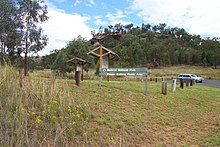Wollemi National Park: Difference between revisions
| Line 65: | Line 65: | ||
* [[Oil shale]] Mining |
* [[Oil shale]] Mining |
||
* [[Glen Davis, New South Wales|Glen Davis]] |
* [[Glen Davis, New South Wales|Glen Davis]] |
||
Camping |
|||
==References== |
==References== |
||
Revision as of 22:39, 12 August 2012
| Wollemi National Park | |
|---|---|
| Lua error in Module:Location_map at line 526: Unable to find the specified location map definition: "Module:Location map/data/Blank Map Australia.png" does not exist. | |
| Location | New South Wales, Australia |
| Nearest city | Sydney |
| Area | 5,017 square kilometres (1,937 sq mi) |
| Established | December 1979 |
| Governing body | National Parks and Wildlife Service |
| World Heritage site | November 2000 |
| www | |
Wollemi National Park is the second largest national park in New South Wales, and contains most of the largest wilderness area, the Wollemi Wilderness. It lies 129 kilometres northwest of Sydney, and forms part of the Greater Blue Mountains World Heritage Area.
It contains the only known wild specimens of the Wollemi Pine (Wollemia nobilis), a species thought to have become extinct approximately thirty million years ago, but discovered alive in three small stands in 1994.
Geology
This park is located on the western edge of the Sydney Basin. It sits on four strata of sedimentary rock; the Narrabeen and Hawkesbury sandstone and shale, the Illawarra and Singleton Permian coal measures and the Wianamatta shales. The strata at this area of the Sydney Basin have an upwards tilt to the north-west. Throughout most of the park the Hawkesbury and Wianamatta series have been eroded away exposing the Narrabeen group. The landscape of the park is dominated by deep valleys, canyons, cliffs and waterfalls, formed by the weathering of the sandstone and claystone the Narrabeen group consists of. The parts of the park that lie on the Narrabeen and Hawkesbury sandstones generally have shallow soil with low nutrient levels while areas that lie on the Wianamatta shale usually have deeper and more nutrient rich soils allowing for a greater diversity of plant life.[citation needed] The coal measures are visible beneath cliff lines along river valleys. This layer is generally rich in nutrients and weathers to form deep clay loams. Tertiary basalt is common in the north west of the park. Basaltic peaks include Mount Coriaday, Mount Monundilla and Mount Coricudgy, the highest peak in the northern Blue Mountains. In some location the basalt in the core of extinct volcanoes has eroded faster than the surrounding sandstone.

The Wollemi National Park is key in maintaining the quality of many tributary rivers to the Hawkesbury River and Goulburn-Hunter River catchments. The national park incorporates rivers such as the Wolgan River, Colo River and Capertee River which arise from outside the park. The Colo River is regarded as the last unpolluted river in New South Wales because the majority of it flows through the Wollemi National Park.
Biology and ecology
Eucalypt dominated open forests comprise 90% of Wollemi National Park, with over 70 species of Eucalypt recorded. The remaining 10% of the National Park comprises rainforest, heath and grassland.
The variety of habitats within Wollemi National Park allow for large diversity in animals. 58 reptile species, 38 frog species, 235 bird species and 46 mammal species have been recorded in the park.
As well as the Wollemi Pine and Wollemi Mint Bush, the park contains populations of the rare Banksia conferta subsp. penicillata, only described in 1981. The Wollemi Stringybark is a recently discovered new species of Eucalyptus tree.
Aboriginal Sites
There are many aboriginal sites within the park including cave paintings, axe grinding grooves and rock carvings. In 2003 the discovery of Eagle's Reach cave was publicly announced. This site was found by bushwalkers in 1995 but remained unknown to the wider community until a team from the Australian Museum reached the cave in May 2003. The art within this small cave is estimated to be up to 4,000 years old and it consists of up to a dozen layers of imagery depicting a wide variety of motifs rendered in ochre and charcoal. The team who recorded this site counted over 200 separate images, mainly of animals and birds but also stencils of hands, axes and a boomerang.
It is a very significant site and the remote location is being kept secret for its own protection.
Activities


Historical Places
References
National Parks and Wildlife Service (2001). "Wollemi National Park Plan of Management" (PDF). Retrieved 2006-06-22.
Samantha Mattila (2003). "Ancient World of Wollemi Pine Reveals New Treasure". Retrieved 2006-07-26.
